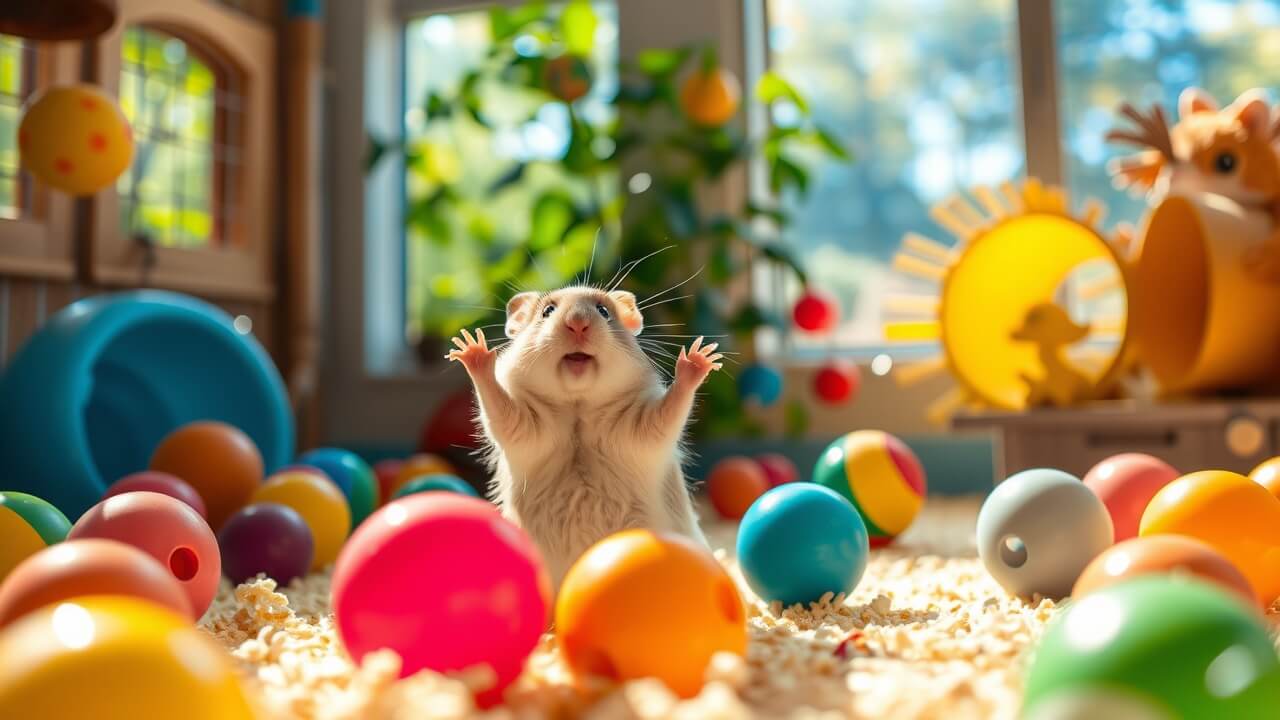
Understanding your hamster’s emotional well-being is crucial for ensuring a happy and healthy pet. A bored hamster can exhibit a variety of negative behaviors, making it essential for pet owners to recognize the signs of engagement and boredom. This comprehensive guide will help you identify whether your hamster is thriving in its enclosure or if it may require more stimulation and interaction.
Signs Your Hamster Is Engaged and Happy
1. Active Exploration
One of the primary indicators that your hamster is not bored is active exploration of its environment. A curious hamster will frequently venture around its cage, investigating every nook and cranny. Look for signs of your hamster sniffing around, climbing on toys, or burrowing in bedding. This behavior shows that your hamster is stimulated and satisfied with its living space.
2. Regular Exercise Habits
Hamsters are naturally active creatures, especially during the crepuscular hours (dawn and dusk). If you notice your hamster frequently using an exercise wheel or engaging in other forms of play, such as running through tunnels or climbing structures, it is a positive sign. A hamster that engages regularly in physical activity demonstrates that it is not bored and has ample opportunities for exercise within its enclosure.
3. Interactivity with Toys
The presence of toys is essential for a hamster’s mental stimulation. If your hamster enjoys chewing, rolling, or manipulating its toys, it indicates a healthy state of mind. Look for signs that your hamster is interacting with various types of chew toys, puzzle toys, or foraging toys. This behavior shows that it finds its environment interesting and that it is creatively engaging with available resources.
4. Healthy Eating Habits
A hamster that is well-adjusted and not bored will display healthy eating habits. If your hamster consumes its meals eagerly and shows interest in a varied diet, it signifies that the enclosure provides a stimulating environment. Signs of boredom may include excessive hoarding or overeating out of lack of stimulation. Make sure to offer a variety of fresh fruits, vegetables, and seeds to keep mealtime exciting.
Recognizing Positive Behaviors
5. Social Interaction

If your hamster is comfortable with handling and enjoys bonding time with you or other humans, it indicates that it feels secure and engaged in its environment. Your hamster may even display friendly behaviors such as nuzzling and climbing onto your hand. This social interaction can be a significant contributor to your pet’s happiness, reducing feelings of loneliness that may arise from boredom.
6. Exhibiting Natural Behaviors
Hamsters have instinctual behaviors such as digging, nesting, and foraging. If your hamster is actively engaging in these activities—like creating a cozy nest in its bedding or digging through its substrate—this is a strong sign of a content hamster. Providing ample bedding materials and toys will encourage these behaviors, keeping your hamster entertained and satisfied.
7. Vocalization and Playfulness
Some hamsters, especially Syrians, might exhibit vocalizations when they are happy or excited. These can include soft squeaks or other sounds during playtime. If your hamster is vocalizing in a pleasant manner while it plays, this can indicate enjoyment and engagement. Playfulness, such as running through tubes or playing with toys, reinforces that your hamster is not bored.
Creating an Engaging Environment
8. Size of the Cage Matters
To ensure that your hamster enjoys a non-boring environment, the size of the cage is critical. The minimum recommended size for a single Syrian hamster is 24”x12” with adequate height for climbing. A larger cage allows for more toys, tunnels, and enrichment items, which can keep your hamster entertained and engaged in its habitat.
9. Variety of Enrichment
Providing a range of stimuli is essential for preventing hamster boredom. Change and rotate your hamster’s toys regularly to maintain interest. Introducing new items such as tunnels, climbing frames, and chewable toys can spark your hamster’s curiosity. Furthermore, consider incorporating foraging activities by hiding treats around the cage, promoting natural hunting instincts that stimulate your hamster mentally and physically.
10. Scheduled Playtime Outside the Cage

Regularly allowing your hamster time outside its cage can provide new experiences that enrich its life. Create a safe space for your hamster to explore—like a hamster-proofed room—where it can run, climb, and explore in safety. This interaction outside the cage boosts social enrichment and satisfies your hamster’s natural instincts, helping to prevent boredom.
Monitoring and Adjusting Your Hamster’s Environment
11. The Importance of Routine
Establishing a routine can be beneficial for your hamster’s well-being. Ensure that you have a schedule for feeding, cleaning, and playtime. Keeping a consistent routine can help your hamster feel secure and adjust better to its surroundings, minimizing stress and boredom.
12. Assessing Behavioral Changes
Be vigilant in observing any changes in your hamster’s behavior, as these can signal boredom or stress. Increased lethargy, excessive chewing on cage bars, or signs of aggression can indicate that your hamster requires more stimulation or a change in environment. Be proactive and make adjustments based on these observations.
Conclusion
Ensuring your hamster is not bored is vital for its mental and physical well-being. By paying attention to specific behaviors, creating an enriching environment, and providing varied experiences, you can foster a stimulating habitat that nurtures your hamster’s needs. Remember, an engaged hamster is a happy hamster, leading to a rewarding relationship between you and your furry friend. Regularly monitor your pet’s activity levels, adapt its environment, and embrace the joy of a lively and healthy hamster.





